
The yellow-tail, goldtail moth or swan moth is a moth of the family Erebidae. The species was first described by Johann Kaspar Füssli in 1775, and has commonly been placed within the related genus Euproctis. It is distributed throughout Europe to the Urals, then east across the Palearctic to Siberia and south to India and Sri Lanka.
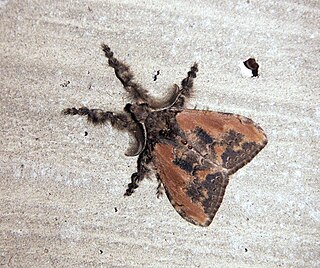
Olene mendosa, the brown tussock moth or hairy tussock moth, is a species of moth in the family Erebidae. The species was first described by Jacob Hübner in 1823. It is found in India, Bangladesh, Sri Lanka, Indonesia, Taiwan, Thailand and Australia.

Cephonodes hylas, the coffee bee hawkmoth, pellucid hawk moth or coffee clearwing, is a moth of the family Sphingidae. The species was first described by Carl Linnaeus in 1771. A widely distributed moth, it is found in the Near East, Middle East, Africa, India, Sri Lanka, Japan, Southeast Asia and Australia.

Porela vetusta, the ancient porela, is a moth of the family Lasiocampidae. It was first described by Francis Walker in 1855. It is found in the Australian states of New South Wales, Queensland, Tasmania and Victoria.

Pergesa is a monotypic moth genus in the family Sphingidae first described by Francis Walker in 1856. Its only species, Pergesa acteus, the green pergesa hawkmoth, was described by Pieter Cramer in 1779.

Trabala vishnou, the rose-myrtle lappet moth, is a species of moth in the family Lasiocampidae. It is found in southern Asia, including Pakistan, India, Bangladesh, Thailand, Sri Lanka, Myanmar, China, Japan, Taiwan, Vietnam, and Indonesia. Four subspecies are recognized.

Biston suppressaria, the tea looper, is a moth of the family Geometridae. It is found in China, India, Myanmar, Nepal, and Sri Lanka.

Orgyia postica, the cocoa tussock moth or hevea tussock moth, is a species of moth of the subfamily Lymantriinae of the family Erebidae found in the Oriental tropics of India, Sri Lanka, Myanmar, Borneo, Java, New Guinea, and Taiwan. It was described by Francis Walker in 1855.
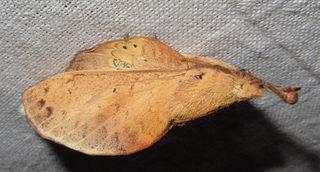
Gastropacha pardale, the brown lapped moth, is a moth of the family Lasiocampidae. The species was first described by Francis Walker in 1855.
Streblote dorsalis is a moth of the family Lasiocampidae first described by Francis Walker in 1866. It is found in India, Sri Lanka, the Philippines, Borneo, Indonesia and Java.

Suana concolor is a moth of the family Lasiocampidae first described by Francis Walker in 1855. It is found in India and Sri Lanka, to South China, Java, Borneo and the Philippines.
Antheraea cingalesa, the Sri Lankan tussar silk moth, is a moth of the family Saturniidae. The species was first described by Frederic Moore in 1883. It is endemic to Sri Lanka.
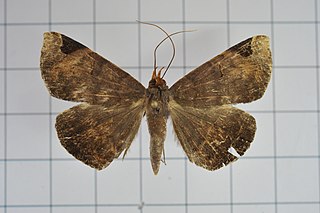
Mecodina praecipua is a moth of the family Noctuidae first described by Francis Walker in 1865.
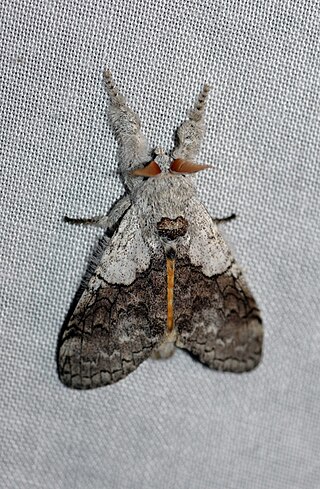
Calliteara horsfieldii, or Horsfield's tussock moth, is a moth of the family Erebidae. The species was first described by the British entomologist Edward Saunders in 1851, and named in honor of the British naturalist Thomas Horsfield, who traveled southern Asia and published works on zoology from the region. C. horsfieldii can be found in southern Asia, the islands of the northern Indian Ocean, and many parts of south east Asia and Indonesia. It is also sometimes referred to as the Yellow Tussock Moth.
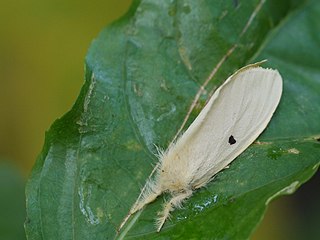
Euproctis lunata, the castor hairy caterpillar, is a moth of the family Erebidae. The species was first described by Francis Walker in 1855. It is found in India, Pakistan, Sri Lanka and Thailand.
Nygmia xanthomela is a moth of the family Erebidae first described by Francis Walker in 1862. It is found in Sri Lanka, Borneo, Java, Sumatra and Peninsular Malaysia.
Laelia suffusa is a moth of the family Erebidae first described by George Hampson in 1893. It is found in Bangladesh, Sri Lanka, Java, East Indies, Sundaland, the Philippines and Sulawesi.

Polytela gloriosae, the Indian lily moth or lily caterpillar, is a moth of the family Noctuidae. The species was first described by Johan Christian Fabricius in 1781. It is found in Sri Lanka, India and probably in Indonesia.

Maceda mansueta is a moth of the family Nolidae first described by Francis Walker in 1857. It is found in Japan, Sri Lanka, Borneo, India (Andamans), Malaysia, New Guinea, Fiji, Australia, Réunion and the Seychelles.

Trabala pallida is a species of moth in the family Lasiocampidae. They can be found from Southeast China, south throughout Thailand and most of Sundaland. One subspecies is Trabala pallida montana.















